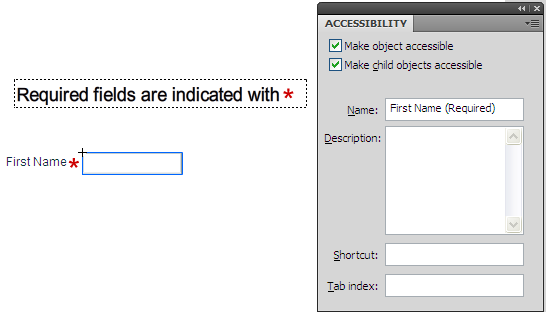See Understanding Techniques for WCAG Success Criteria for important information about the usage of these informative techniques and how they relate to the normative WCAG 2.0 success criteria. The Applicability section explains the scope of the technique, and the presence of techniques for a specific technology does not imply that the technology can be used in all situations to create content that meets WCAG 2.0.
Adobe Flash Professional version MX and higher
Adobe Flex
This technique relates to:
Note: This technique must be combined with other techniques to meet SC 3.3.2. See Understanding SC 3.3.2 for details.
See User Agent Support Notes for FLASH10. Also see Flash Technology Notes.
The objective of this technique is to provide a clear indication that a specific form control in a Web application or form is required for successful data submission. The word "required" is added to the form control's accessible name, and a visual indicator is placed next to the label.
This example shows how to use the Accessibility panel to indicate a field as being 'required' to users:
Visually, place asterisk character or some other indication adjacent to the form control's label.
Use the Accessibility panel to combine the word "required" with the control's label in the "Name" field.
This approach is illustrated in the screenshot below:

This is demonstrated in the working example of Adding the word "required" to the control's accessible name. The source of Adding the word "required" to the control's accessible name is available.
For each required form control within a Flash movie, confirm that:
The required state is indicated visually
The required state is indicated textually using the 'Name' field in the Accessibility panel
Each of the above is true
If this is a sufficient technique for a success criterion, failing this test procedure does not necessarily mean that the success criterion has not been satisfied in some other way, only that this technique has not been successfully implemented and can not be used to claim conformance.